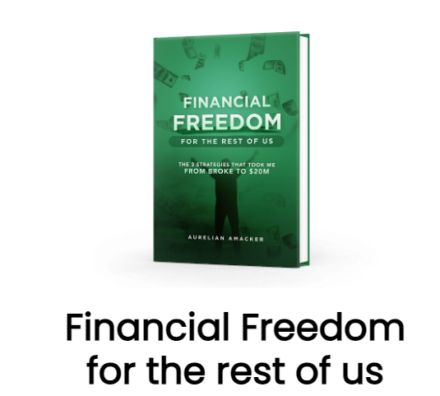Getting out of the rat race is simple, but not necessarily easy.
To escape, all you need is monthly income — from non-job sources — that exceeds your monthly expenses.
For example, if you spend $3000 a month, you’ll need to bring in at least $3000 (after taxes) outside of your day job.
Simple, but not always easy.
In this post, I’ll break down:
the most common rat race “escape routes”
the pros and cons of each
how to choose the right path for you
Ready? Let’s do it!
The Rat Race, Defined
The term “rat race” means different things to different people, but let’s see if I can paint a picture.
You might feel like you’re stuck in the rat race if you’re:
commuting in traffic
to a job you don’t love
to barely get by
There’s a certain circular rhythm to your days, weeks, or even your years. You’re spinning your wheels but not getting anywhere. You perform tasks, go through the motions, and sometimes even get rewarded for your efforts … but you still feel trapped.
A friend put it this way: “We work jobs we don’t like, to buy stuff we don’t need, to impress people we don’t know.”
Is this what adulting is supposed to be like?
There’s got to be more to life, right?
The 3 Most Common Paths to Getting Out of the Rat Race
Remember our escape math from earlier:
Non-job income that exceeds your monthly expenses.
The 3 most common ways to generate that income are:
Traditional investments
Real estate
Entrepreneurship
These are in contrast to–and far more realistic than–other paths some people bank on, like:
An unexpected inheritance
A lonely Nigerian prince
Winning the lottery
Figure Out Your Spending
Living frugally — or at least spending with intention — is an important part of your rat race escape plan. The less you spend, the less income you’ll need to break free.
If you’ve never calculated how much you actually spend on a monthly basis, it’s worth taking a minute to figure it out.
Do you spend $3000 a month? Do you spend $10,000 a month?
How much does your lifestyle cost?
This is the income you need to generate — this is your Rat Race Freedom Number.
So how do real people achieve it?
1. Save Your Way Out with Traditional Investments
The most commonly-prescribed path to escape the rat race is through traditional investments, like:
Stocks
Bonds
Mutual funds / ETFs
How Traditional Investing Works to Escape the Rat Race
This is how “retirement” has worked for generations — amass a big enough nest egg during your working years and then slowly draw down on those savings after you stop working.
At that point, you’re literally getting paid to do nothing … but the problem is you probably don’t want to wait decades until you’ve saved enough!
The FIRE (Financial Independence / Retire Early) movement has an alternative for you, and argues that retirement isn’t an age, but rather a number. According to the oft-cited Trinity study, once you accumulate 25x your annual expenses, you’re free.
Spend $40,000 a year? You could theoretically leave the rat race behind with $1 million in traditional investments, and live off dividends and share price appreciation for decades.
Spend $100,000 a year? You’d need $2.5 million.
Advantages of Traditional Investing
These so-called “paper assets” are accessible to just about everyone — you can even invest right from your phone with services like Robinhood. (They’ll even give you a free share of stock to get you started.)
Stocks, bonds, and mutual funds and ETFs are also highly liquid, meaning you can buy and sell them quickly.
And over the long run, they’ve historically performed very well. Projecting 7-9% annualized returns would be realistic.
Disadvantages of Traditional Investing
The big drawback is trying to get out of the rat race with traditional investing either takes a lot of time or a lot of money.
Despite enthusiasm from the FIRE community, the truth is unless you have a wide margin in your personal finances — the gap between what you earn and what you spend — there’s no real way to shortcut building up that nest egg.
Plus, should unexpected expenses pop up during retirement, your withdrawal rates and assumptions can go out the window.
Who is Traditional Investing Best For?
This path may be the best way to escape the rat race for high earners who live a relatively inexpensive lifestyle.
If you (or you and your significant other) bring in $300k a year, but only spend $50k, this is a great option. Ignoring taxes for a second, you can see how it would only take 5 years of “profiting” $250k a year as a household to accumulate the $1.25 million you’d need to support your lifestyle in retirement.
If your work is tolerable, 5 years will fly by — and that assumes you’re starting at $0 savings today.
On the other hand, if you make $50k a year, and spend $49k, traditional investing is never going to get you out of the rat race. There’s simply not enough margin there.
Which brings us to option #2…
2. Beat the Rat Race with Real Estate
The next common rat race escape path is real estate, and for the sake of this post, I’ll focus on rental property investing.
(Real estate comes in many different flavors and strategies, many of which have been covered on Side Hustle Nation.)
How Real Estate Works to Escape the Rat Race
Real estate is appealing for its easy-to-understand business model:
Buy a house, rent it out, and pocket the difference between that rent and your monthly expenses.
Lather, rinse, and repeat until you’ve got enough monthly cash flow to quit your job.
For folks like Dustin Heiner, that was around 26 properties and $15k a month in reliable cash flow. He “retired” at 37 and supports his family off the income from this rental property empire.
Invest with that monthly cash flow in mind, and use it to slowly start chipping away at your own living expenses.
Advantages of Real Estate
Rental property investing can accelerate your climb to financial independence in several important ways.
First, you can take advantage of leverage — borrowing money. In contrast to traditional stock market investing described above, where $20,000 buys you $20,000 worth of stocks, that same $20,000 could be used as a down payment to buy $100,000 or more worth of real estate.
Then you can pay down that loan balance from the rental income you receive over the next 30 years.
The next big advantage of real estate is appreciation. As you know, houses tend to cost more today than they did a generation ago.
By owning those properties, you can capture this appreciation when you sell — or borrow against the equity in your houses to fund future acquisitions.
Third, being a landlord comes with several tax benefits, including the ability to write off your mortgage interest and even take depreciation on the buildings you own.
And finally, real estate can be a very passive income stream once you have your tenants and other relevant team members in place. There’s an upfront time investment, but no trading hours for dollars down the road.
Disadvantages of Real Estate
Home prices don’t fluctuate as wildly as the stock market, but investing in physical assets takes more legwork and also means your cash isn’t as liquid.
(You can’t exactly just press a button on your phone and sell a house when you need cash.)
And although there are some creative ways to buy houses for no money down, real estate is usually a “takes money to make money” option.
As a landlord, you’ll also face:
Vacancies – If the house sits empty, that erases any positive cash flow you were banking on.
Repairs and maintenance – Roofs, windows, toilets, water heaters … nothing lasts forever and it all costs money.
Unexpected expenses – Our friends had to re-do their foundation to the tune of $90,000!
Tenant issues – Why some humans think it’s acceptable behavior to trash other humans’ houses is beyond me, but it happens.
On top of that, your local real estate market might not be a great place to invest so you’ll be dealing with all this remotely or through a third-party property management service.
Who is Real Estate Investing Best For?
The people I see having the best success with real estate are those who take a long-term view and are committed to operating multiple properties.
Especially if you can buy multiple properties in one location, there are some economies of scale that make life easier than having only one house or having houses in different cities across the country.
As your empire grows, you’re better able to absorb a vacancy or unexpected expense for one or two of your properties in a given month.
You Might Like: House Hacking 101: Live Free and Turn Your Biggest Expense into a Profit Center
Alternative: With Fundrise, you can begin adding real estate to your portfolio with as little as $10. This appeals to me as a way to benefit from real estate in a way that’s diversified and totally hands-off.
Disclosure: I’m a Fundrise investor. If you join through my referral link, I earn a commission. Opinions are my own.
But just like traditional investing, real estate can and does work to escape the rat race — if you have the capital, patience, and fortitude to stay the course.
Still, there’s another rat race escape path you need to know about…
3. Escape the Rat Race with Entrepreneurship
The third way to get out of the rat race is to build your own business.
If you look at the Forbes 400 list of the richest people in America, one thing should stand out: most built their wealth through entrepreneurship.
And even if you have no aspirations to build the next Amazon or Facebook (I certainly don’t!), building a business is a realistic way to break out of the 9-5 grind.
It’s how I was able to walk away from corporate America, years before starting Side Hustle Nation. Entrepreneurship has helped 100s (maybe even thousands now!) of friends, Side Hustle Nation readers, and Side Hustle Show listeners do the same!
How Entrepreneurship Works to Escape the Rat Race
We tend to overcomplicate entrepreneurship, but I’ll try and break it down here.
A business is simply a system that solves a problem in exchange for money. It’s a problem solving machine.
That means to come up with a business idea, you really need to come up with a problem. Think of:
what frustrates you
the headaches or challenges you’ve overcome
what other people complain about
On the other side of those problems, there might be a business idea.
The solution usually takes one of 3 forms:
A service that makes that problem go away. Dirty house? You can hire a cleaning service.
A product that makes that problem go away. Dirty house? You can buy cleaning products.
“Content” that makes that problem go away. Dirty house? You can watch YouTube videos about how to organize and optimize your space.
And when the money from your solution starts to exceed your living expenses, it’s au revoir rat race 🙂
I break down these 3 business models in detail, with lots of examples, in my book, The Side Hustle: How to Turn Your Spare Time into $1000 a Month or More. It’s free on Kindle!
You’ll also find tons of side hustle ideas throughout this site and in The Side Hustle Show podcast archives.
Advantages of Entrepreneurship
Building a business is unique in that your primary investment is “sweat equity.” These days, you can get an enterprise off the ground for a very low startup cost.
On top of that, starting a business is a way to work on something you care about. Bringing an idea into the world is exciting and rewarding in a way that collecting stock dividend payments just isn’t.
And in contrast to the stock market or real estate market, you have considerably more control over the success and failure of a business you own. (And the speed at which that can happen.)
Plus, if you intentionally build something with scale, you’ll find entrepreneurship to be time-leveraged. By that I mean your earning power — or effective hourly rate — improves as your business grows.
Disadvantages of Entrepreneurship
With job security in question and the shift toward a freelance workforce, it’s hard for me to see the downsides in learning an entrepreneurial skillset.
Still, the fact remains that 50% of small businesses fail in their first 5 years. For that reason, it’s important to start small, minimize your expenses, and grow at a pace you’re comfortable with.
Building a business can be labor intensive, and many entrepreneurs find themselves in a trap of working in the business rather than on it. They feel like they’ve built themselves a job … only one with a really demanding boss that’s even harder to walk away from.
Who is Entrepreneurship Best For?
I believe entrepreneurship is the most realistic rat race escape path for most people, but especially those who:
Don’t have the “golden handcuffs” of a great-paying job
Aren’t afraid of failure
Are a little impatient
Entrepreneurship appealed to me because I couldn’t fathom the reality of working a corporate job for the next 30 years. There had to be a better way!
And there was.
Why Do You Want to Escape the Rat Race?
What’s beyond the walls of the rat maze for you?
While “escape” can be a powerful motivator, I think it’s helpful to know what you’re escaping to. If you weren’t tied to your job for income, what would you do instead?
For Side Hustle Nation readers, motivations include:
A location-independent lifestyle — not being restricted to one part of the world
Early retirement
Less stress
Working from home
Leaving the big city for a slower pace of life
For me, my driving force was to gain freedom over how I spent my days … hence pictures like this:
When I worked a corporate job, it just rubbed me the wrong way that I had to ask someone else (my boss) if I could take vacation on certain days.
I also wanted to see the direct impact of my work on my bottom line — something I didn’t get at the day job. If I did great or did poorly, my paycheck remained the same.
Not super motivating.
With my side hustle, on the other hand, the harder I worked, the more I made.
For me, getting out of the rat race wasn’t about never working again. I just wanted more flexibility, control, and earning power from my work.
Alternative: Find a Job you Love
For many people, escaping the rat race could be as simple as getting out of a toxic commute and work environment.
If you found a job you loved, and maybe offered you some time and location flexibility, do you think you’d feel a little less like a rat?
Here are some top choices for legit work from home jobs.
1. FlexJobs
With over 50 career categories, FlexJobs has jobs ranging from entry-level to executive and freelance to full-time.
The leading work from home jobs site charges a nominal monthly fee (save 30% w/ promo code FLEXLIFE) to access their listings, but you’ll easily earn that back and then some with one job.
2. SolidGigs
One of my favorite platforms to help connect your skills to paying freelance clients and projects is SolidGigs. Every day, they curate the best freelance jobs in:
marketing
writing
design
development
Plus, they’ve got an awesome library of resources to help you learn how to best pitch and price your services.
SolidGigs is free to try.
3. Hired
Hired.com helps designers, engineers, data scientists, and managers by connecting them with prospective employers.
The site is free to join, and one thing that’s cool about Hired is they also help you get the best offer by letting companies compete for your services — instead of you getting into a bidding war with other workers.
The company caters to people looking for full-time, part-time, and freelance gigs.
Click here to learn more and create your free Hired profile.
Your Move, Rat Race Escape Artist
Which is the best path for you? Of course, it depends on your interests and starting points.
If you’d like to learn more about starting a side hustle, I think you’ll get a ton of value from my Start My Side Hustle Workbook.
It’s normally $49 but I thought I’d test offering it for just $19 for a limited time.
Serious About Making Extra Money?
Start Your Free $500 Challenge. My free 5-day email course shows you how to add $500 to your bottom line.
Join the free Side Hustle Nation Community. The free Facebook group is the best place to connect with other side hustlers and get your questions answered.
Download The Side Hustle Show. My free podcast shares how to make extra money with actionable weekly episodes.
*************
Photos courtesy of Depositphotos.


















